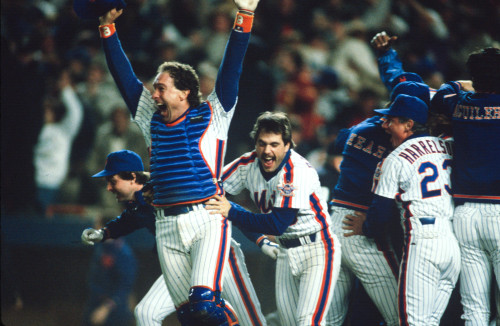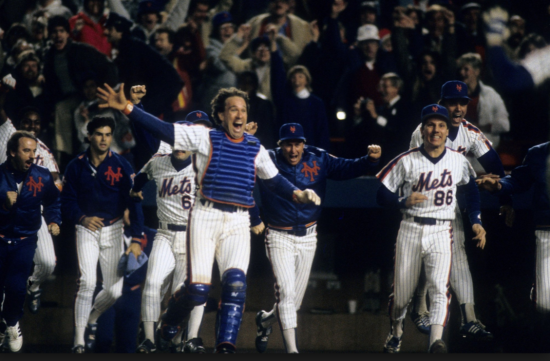
Rarely, if ever, has a team better represented its time and place than the 1986 New York Mets. That is at the heart of a four-part ESPN 30 for 30 documentary produced and directed by Nick Davis and executive produced by Jimmy Kimmel and Sal Iacono, which premiered Tuesday and is available to stream on ESPN+.
But there’s so much more in the story of the Big Apple’s most fascinating baseball team — a group of characters that were brawling, belligerent, and the league-leaders in bravado. In the end, they won — 108 times over the course of a dominant regular season and eight more times in a taught, tension-filled postseason.
The World Series victory was the culmination of a nine-year climb from nadir. The Mets’ darkest moment, trading Tom Seaver to Cincinnati in June 1977, just about coincides with a city-wide blackout the next month. That’s where the parallels between New York and New York’s National League club begin and truly come to fruition in the mid-80s.
For those who’ve yet to watch, here’s a brief — and certainly not complete — summary of the highlights with additional content to serve as a complement to the film:
- Major points of reference were footage from a documentary film crew that followed the team that year, the season’s team-produced highlight video “A Year to Remember“, and Jeff Pearlman’s 2004 book The Bad Guys Won. Pearlman is one of the many great interview subjects, as is Greg Prince — a true Mets savant.
- Part 1 delves into the Mets’ origin and timeline leading up to the Seaver trade, as well as the building of the team starting in 1980 under new ownership.
- As far as the newness of content is concerned, there is definitely stuff you likely have never seen or heard before — a mic’d up Gary Carter in spring training, for instance.
- Backstories are provided for the main characters: Darryl Strawberry, Keith Hernandez, Dwight Gooden, and Carter (who’s represented in interviews by his widow, Sandy). Hernandez’s relationship with his father and brother (accompanied by home video footage) is very poignant. He comes off as the central figure, especially so in the years preceding ’86 establishing himself as the team leader. Then too are the masterminds behind the club’s development: bow-tied general manager Frank Cashen and self-assured manager Davey Johnson.
- The supporting cast, no less crucial to the team’s makeup, is featured, too: Mookie Wilson, Kevin Mitchell, Bob Ojeda, Wally Backman, Ron Darling, and Ray Knight. The Mets succeeded primarily because of the contributions from nearly everyone on the roster.
- Then there’s Lenny Dykstra. If you dare engage in a drinking game predicated on him saying the something profane, you’d probably be drunk during Part 2.
- If you’ve checked social media lately, you probably were hinted to the real scene-stealer: Hadji (aka Keith’s cat).
- Here’s some ear candy: Bob Murphy and Gary Thorne’s radio calls are frequent. As is the voice of Ralph Kiner. Part 1’s end credits pay special tribute to the Hall of Famer.
- Part 2 ends with a montage of the madness that unfolded in Cincinnati on July 22. Here is the full broadcast (Reds announcers), but jump to the 2:56:05 mark to begin with the melée instigated by Knight and Eric Davis.
- A recurring theme weaved into the story is the lifestyle and social scene of New York City in the 1980s. The Mets indulged in it. Greed and grittiness were at the core of the city’s personality. So too were those elements a central part of the NL team which played there.
- That leads to an inescapable detail of this team: off-the-field behavior. The film offers context when it comes to drug use, drinking, misogyny, and other assorted debauchery — neither excusing them nor shying away.
- Camcorder footage is used for such events as the NL East clincher on September 17 and Game 3 of the NLCS at Shea Stadium, specifically Backman’s drag bunt to start the ninth and Dykstra’s homer to end it.
- NLCS Game 6 in Houston, an epic of baseball lore, can be seen and heard in all its glory (with Murphy and Thorne’s radio voices over video).
- Spoiler alert: the Mets rally from two down in the 10th of Game 6 in the World Series. What is new is the 57-second tracking shot following Mookie Wilson from the field to the clubhouse after his winning grounder. It’s the best segment of the entire four hours.
- The ’86 Mets distinguish themselves partly because they never won again. There are many factors as to why, some of which had been emerging before and during the championship season — notably, the downfalls of Strawberry and Gooden — and some took place immediately after the World Series — parting ways with Ray Knight and Kevin Mitchell. But when you watch and listen to what took place away from the playing field, it feels like sort of a miracle that they were able to win once.
As you can imagine, plenty more was covered. Be sure to check out our conversation with Nick Davis, which will be happening on Friday.
















